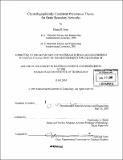Crystallographically consistent percolation theory for grain boundary networks
Author(s)
Frary, Megan
DownloadFull printable version (10.19Mb)
Other Contributors
Massachusetts Institute of Technology. Dept. of Materials Science and Engineering.
Advisor
Christopher A. Schuh.
Terms of use
Metadata
Show full item recordAbstract
Grain boundaries are known to play a role in many important material properties including creep resistance, ductility and cracking resistance. Although the structure and properties of individual boundaries are important, the overall behavior of the material is determined largely by the connectivity of grain boundaries in the microstructure. Grain boundary networks may be studied in the framework of percolation theory by classifying boundaries as special or general to the property of interest. In standard percolation theory, boundaries are randomly assigned as special or general; however, this approach is invalid in realistic grain boundary networks due to the requirement for crystallographic consistency around any closed circuit in the microstructure. The goal of this work is to understand the effects of these local constraints on the connectivity and percolation behavior of crystallographically consistent grain boundary networks. Using computer simulations and analytical models, the behavior of crystallographically consistent networks is compared to that of randomly-assembled networks at several different length scales. At the most local level, triple junctions and quadruple nodes are found to be preferentially coordinated by special and general boundaries, leading to nonrandom network topologies that are quantified using topological parameters. (cont.) Although the properties of the simulated microstructures, including connectivity length and average cluster radius of gyration, are described by the same scaling exponents as in standard percolation theory, the amplitude prefactors in the scaling relationships are changed as a result of the crystallographic constraint. The percolation threshold, an important parameter in microstructural design, is also found to differ from that of standard percolation theory by as much as ±0.05. Although all of the simulated grain boundary networks studied here are distinctly nonrandom, no two cases have the same behavior, the details of which depend strongly on the specific microstructural model. Therefore, a unified approach for locally correlated percolation problems is developed that allows the effects of the requirement for crystallographic consistency to be compared directly from system to system. This new approach can be extended beyond the study of grain boundary networks to include other locally-correlated percolation problems.
Description
Thesis (Ph. D.)--Massachusetts Institute of Technology, Dept. of Materials Science and Engineering, 2005. Includes bibliographical references (p. 127-134).
Date issued
2005Department
Massachusetts Institute of Technology. Department of Materials Science and EngineeringPublisher
Massachusetts Institute of Technology
Keywords
Materials Science and Engineering.